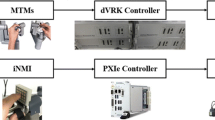Abstract
Purpose
We are currently developing a neurosurgical robotic system that facilitates access to residual tumors and improves brain tumor removal surgical outcomes. The system combines conventional and robotic surgery allowing for a quick conversion between the procedures. This concept requires a new master console that can be positioned at the surgical bedside and be sterilized.
Methods
The master console was developed using new technologies, such as a parallel mechanism and pneumatic sensors. The parallel mechanism is a purely passive 5-DOF (degrees of freedom) joystick based on the author’s haptic research. The parallel mechanism enables motion input of conventional brain tumor removal surgery with a compact, intuitive interface that can be used in a conventional surgical environment. In addition, the pneumatic sensors implemented on the mechanism provide an intuitive interface and electrically isolate the tool parts from the mechanism so they can be easily sterilized.
Results
The 5-DOF parallel mechanism is compact (17 cm width, 19cm depth, and 15cm height), provides a 505,050 mm and 90° workspace and is highly backdrivable (0.27N of resistance force representing the surgical motion). The evaluation tests revealed that the pneumatic sensors can properly measure the suction strength, grasping force, and hand contact. In addition, an installability test showed that the master console can be used in a conventional surgical environment.
Conclusion
The proposed master console design was shown to be feasible for operative neurosurgery based on comprehensive testing. This master console is currently being tested for master-slave control with a surgical robotic system.
Similar content being viewed by others
References
The Committee of Brain Tumor Registry of Japan (2003) Report of Brain Tumor Registry of Japan (1969–1996). Neurol Med Chir Tokyo 43(suppl i–vii):1–111
Eljamel MS (2008) Robotic applications in neurosurgery. In: Medical robotics. InTech, Rijeka, pp 41–64
Zamorano L, Li Q, Jain S, Kaur G (2004) Robotics in neurosurgery: state of the art and future technological challenges. Int J Med Robot Comput Assist Surg 1(1): 7–22
Cossu M, Cardinale F, Castana L, Citterio A, Francione S, Tassi L, Benabid AL, Russo LG (2005) Stereoelectroencephalography in the presurgical evaluation of focal epilepsy: a retrospective anal s of 215 procedures. Neurosurgery 57(4): 706–718
Eljamel MS (2007) Validation of the PathFinderTM neurosurgical robot using a phantom. Int J Med Robot Comput Assist Surg 3(4): 372–377
Guthart GS, Salisbury JK (2000) The intuitive telesurgery system: overview and application. In: Proceedings of international conference on robotics automation 2000, pp 618–621
Sutherland GR, Latour I, Greer AD (2008) Integrating an imageguided robot with intraoperative MRI: a review of the design and construction of neuroArm. IEEE Eng Med Biol Mag 27: 59–65
SensAble Technologies. http://www.sensable.com/. Accessed 2 March 2012
Morita A, Shigeo S, Mitsuishi M (2005) Microsurgical robotic system for the deep surgical field: Development of a prototype and feasibility studies in animal and cadaveric models. J Neurosurg 103(2): 320–327
Goto T, Hongo K, Kakizawa Y (2003) Clinical application of robotic telemanipulation system in neurosurgery. J Neurosurg 99(6): 1082–1084
Arata J, Tada Y, Kozuka H, Wada T, Saito Y, Ikedo N, Hayashi Y, Fujii M, Kajita Y, Mizuno M, Wakabayashi T, Yoshida J, Fujimoto H (2011) Neurosurgical robotic system for brain tumor removal. Int J CARS 6(3): 375–385
Arata J, Kondo H, Ikedo N, Fujimoto H (2011) Haptic device using a newly developed redundant parallel mechanism. IEEE Trans Robot 27(2): 201–214
Arata J, Ikedo N, Fujimoto H (2011) Force producibility improvement of redundant parallel mechanism for haptic applications. In: Proceedings of international conference on intelligent robots and systems 2011, pp 2145–2150
Tokuda J, Fischer GS, Papademetris X, Yaniv Z, Ibanez L, Cheng P, Liu H, Blevins J, Arata J, Golby AJ, Kapur T, Pieper S, Burdette EC, Fichtinger G, Tempany CM, Hata N (2009) OpenIGTLink: an open network protocol for image-guided therapy environment. Int J Med Robot Comput Assist Surg 5(4): 423–434
3D Slicer. http://www.slicer.org/. Accessed 2 March 2012
Hayashi Y, Mori K, Fujii M, Kajita Y, Ito E, Takebayashi S, Mizuno M, Wakabayashi T, Yoshida J, Suenaga Y (2009) Virtual surgiscope: 3D visualization tool for assisting image-guided neurosurgery. Int J CARS 4(sppl 1): S246–S247
Hayashi Y, Takagi M, Arata J, Tokuda J, Yamada A, Hata N, Chinzei K, Kajita Y, Fujii M, Mizuno M, Wakabayashi T, Yoshida J, Mori K (2011) Development of endoscopic robot surgery simulation system using OpenIGTLink. J JSCAS 13(3): 226–227 (in Japanese)
Force dimension. http://www.forcedimension.com/. Accessed 2 March 2012
Author information
Authors and Affiliations
Corresponding author
Rights and permissions
About this article
Cite this article
Arata, J., Kenmotsu, H., Takagi, M. et al. Surgical bedside master console for neurosurgical robotic system. Int J CARS 8, 75–86 (2013). https://doi.org/10.1007/s11548-012-0691-8
Received:
Accepted:
Published:
Issue Date:
DOI: https://doi.org/10.1007/s11548-012-0691-8




